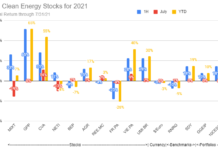by Debra Fiakas CFA
There has been considerable fuss in recent weeks about the Federal Open Market Committee decision to raise its benchmark interest rate. The one-quarter point increase has finally been announced and investors now are watching with bated breath to see how the increased cost of funds at the Fed ‘window’ will impact borrowing costs for companies large and small. In our Beach Boys Index of alternative energy producers, we found a number of companies that rely on debt as a capital source.
However, not all energy producers have debt. So when Janet Yellen made her historic announcement, raising the benchmark interest rate for the first time in over nine years, they just said ‘fuhgettaboutit.’
|
USE OF LEVERAGE; CASH GENERATION
|
|||||
|
Symbol
|
Operating Cash Flow
|
Cash Flow-to-Sales Ratio
|
Cash Balance
|
Debt
|
Debt-to-Equity Ratio
|
|
CERE
|
($23.2M)
|
Neg
|
$8.1M
|
-0-
|
NA
|
|
CDXS
|
($2.5M)
|
Neg
|
$17.0M
|
-0-
|
NA
|
|
LQDT
|
$43.5M
|
11.0%
|
$95.5M
|
-0-
|
NA
|
|
ASTE
|
$28.2M
|
2.8%
|
$15.8M
|
$9.2M
|
1.50
|
|
Trailing twelve months ending September 2015; balances on September 30, 2015
|
|||||
Energy sector investors might be surprised to see Liquidity Services, Inc. (LQDT: Nasdaq) in our index. The company facilitates the recycling of used assets, scrap metal and salvage through its auction marketplace. Recycling is a critical element in energy efficiency. The founders might not have anticipated the duel meaning in the name, yet the company has become very liquid through its track record of turning as much as 11% of its sales into operating cash flow. The success has made it possible to keep a debt-free balance sheet.
Astec Industries, Inc. (ASTE: Nasdaq) is also a net generator of cash through sales of its industrial equipment and components. Astec has been pivotal in helping build geothermal power plants and wood processing plants, both of which are important participants in renewable energy production. Its sales-to-cash conversion rate is a modest 2.8%, but that is enough to maintain a low-debt balance sheet. Astec also has sufficient cash to pay off its long-term debt if their creditors call with a rate increase.
Seed producer Ceres, Inc. (CERE: Nasdaq) has applied it biotechnology to the both food and energy crops. The company is still a net cash user as it struggles to win customers and ramp revenue, relying on the sale of common stock to make ends meet.
Codexis, Inc. (CDXS: Nasdaq) is swimming against and even stronger current. The company has refocused its biocatalysts away from the ethanol and biofuel sectors to pharmaceutical, flavors, fragrances, food and feed applications. The decision appears to have been astute as the company reported a net profit in the quarter ending September 2015. Operating cash flow in the quarter was also positive. With that accomplishment, Codexis management can thumb the corporate nose at interest rate increases as its current cash kitty appears adequate to see the company through to more prosperous times.
Over the last few weeks management teams in every U.S. company have likely put a pen to paper to figure out what an increase in interest rates might mean for their future. However, for these four companies the rate increase poses no immediate problem for them.
Debra Fiakas is the Managing Director of Crystal Equity Research, an alternative research resource on small capitalization companies in selected industries.
Neither the author of the Small Cap Strategist web log, Crystal Equity Research nor its affiliates have a beneficial interest in the companies mentioned herein.








